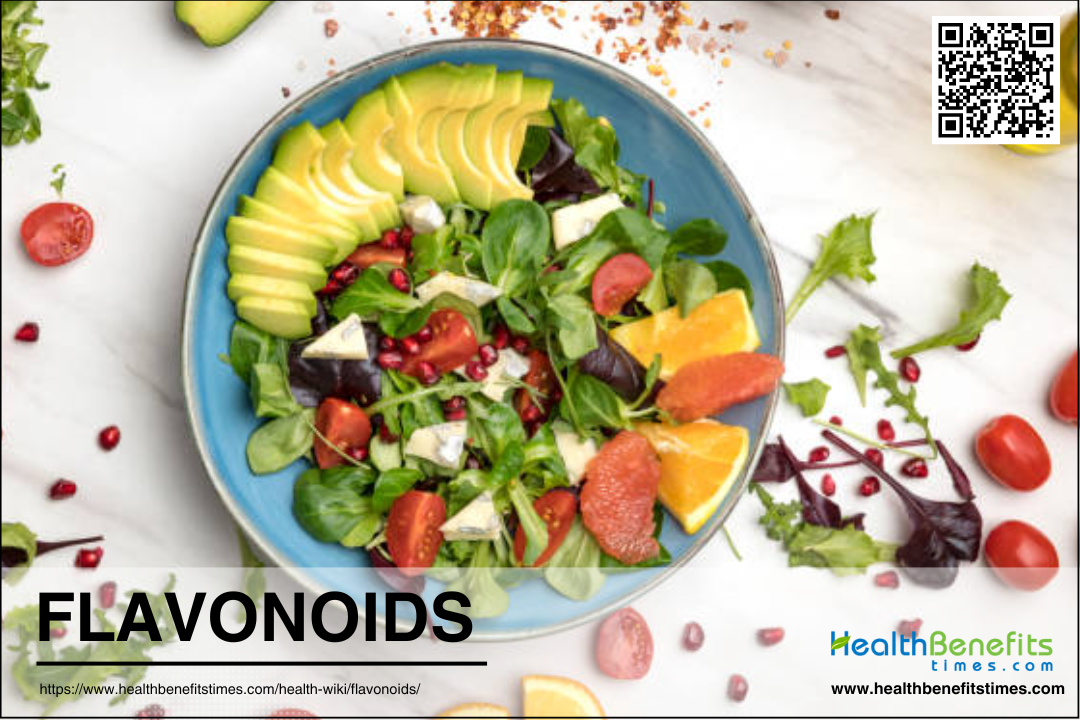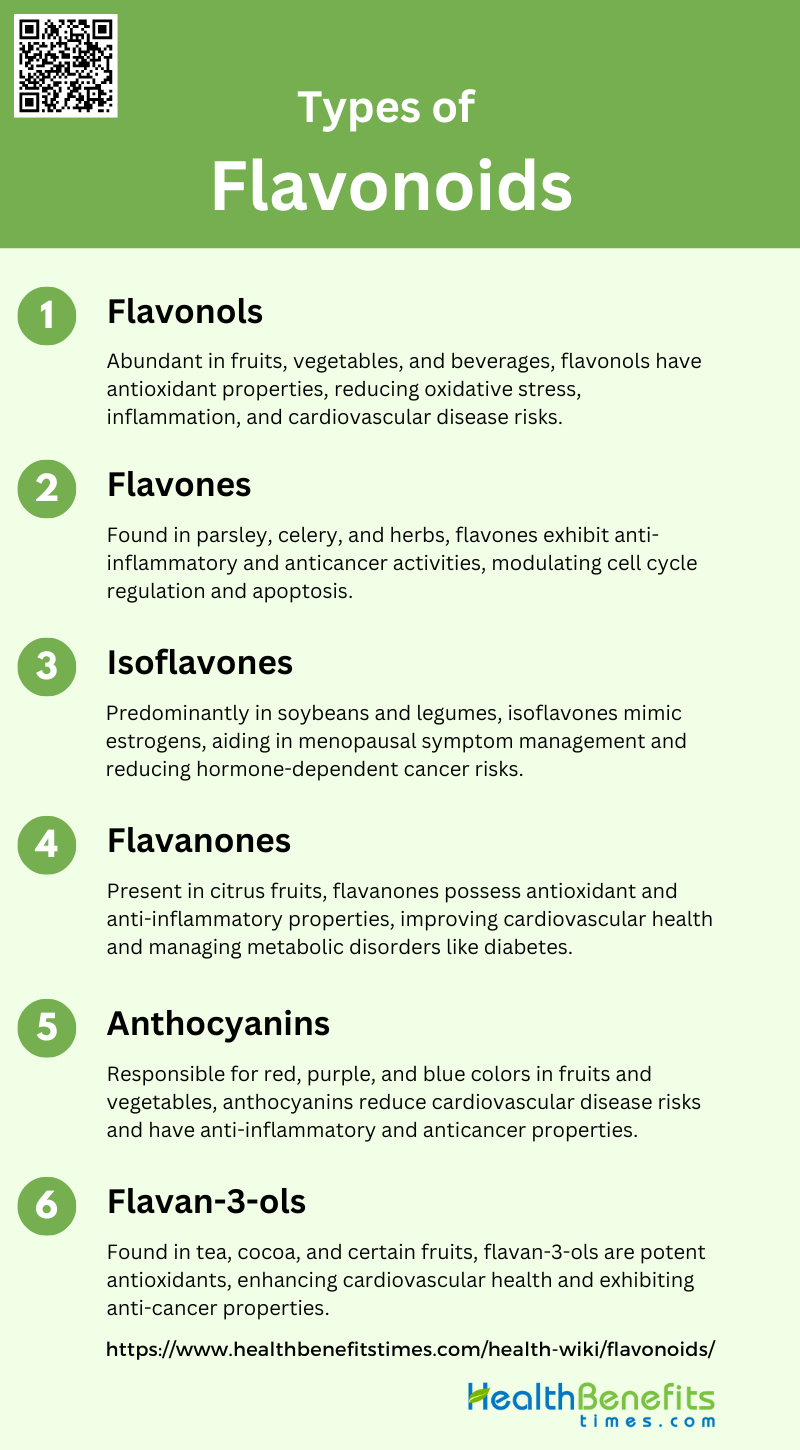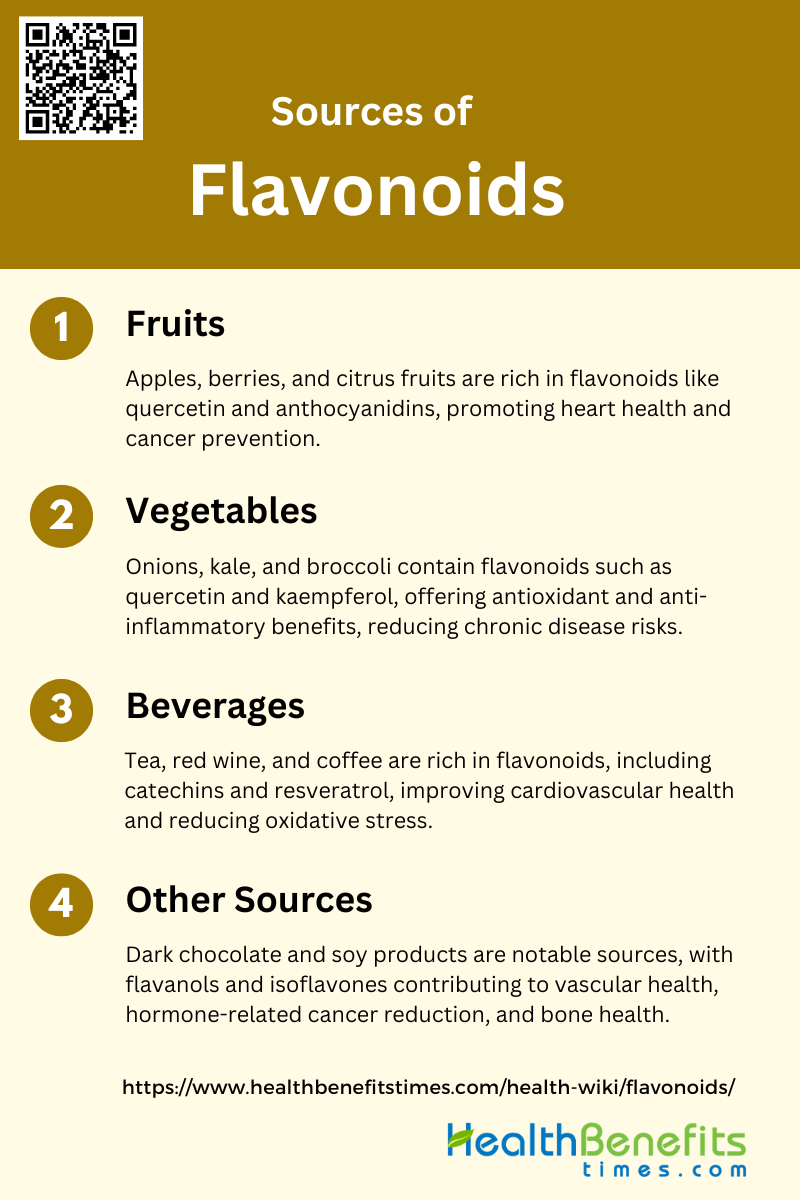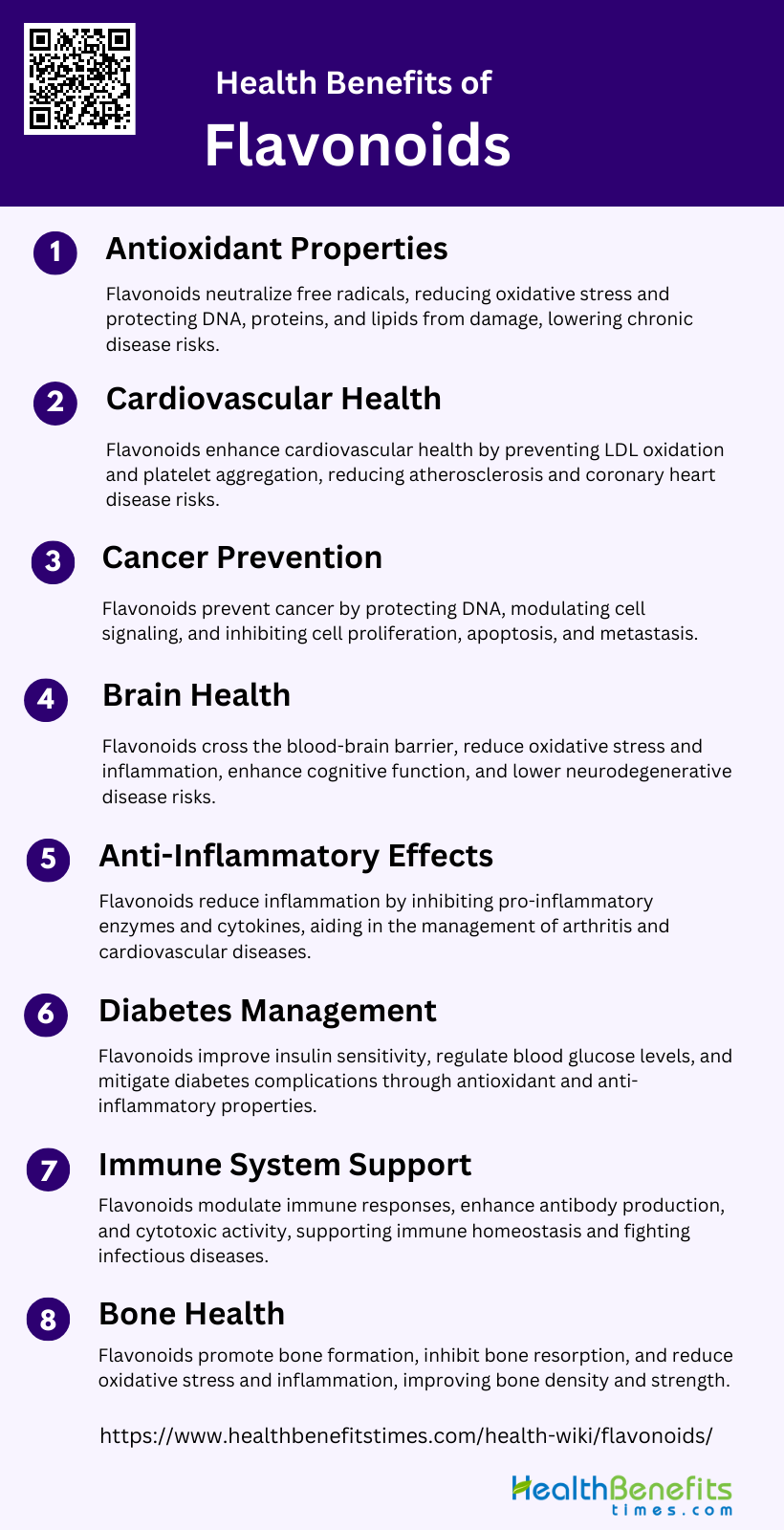Flavonoids are a diverse group of naturally occurring plant compounds that belong to the larger family of polyphenols. These bioactive substances are widely distributed in fruits, vegetables, grains, bark, roots, stems, flowers, tea, and wine. Characterized by their variable phenolic structures, flavonoids typically consist of two phenyl rings connected by a three-carbon bridge, often forming a third ring. They are further classified into several subgroups based on their chemical structure, including flavonols, flavones, flavanones, flavan-3-ols, anthocyanidins, and isoflavones. Flavonoids have gained significant attention in recent years due to their numerous potential health benefits, including antioxidant, anti-inflammatory, anti-mutagenic, and anti-carcinogenic properties. These compounds play crucial roles in plants, helping them combat oxidative stress and regulate growth, while also offering promising applications in nutraceutical, pharmaceutical, medicinal, and cosmetic industries.
Types of flavonoids
Flavonoids are a diverse group of phytonutrients found in many fruits, vegetables, and herbs. They are known for their antioxidant properties and play a significant role in promoting health and preventing diseases. Here are some common types of flavonoids:
1. Flavonols
Flavonols are a major subclass of flavonoids found abundantly in various fruits, vegetables, and beverages such as tea and red wine. They are known for their potent antioxidant properties, which help in scavenging free radicals and reducing oxidative stress. Common flavonols include quercetin and myricetin, which have been shown to possess anti-inflammatory, anticancer, and cardioprotective effects. These compounds inhibit low-density lipoprotein (LDL) oxidation and platelet aggregation, thereby reducing the risk of atherosclerosis and coronary heart disease (CHD).
2. Flavones
Flavones, another important subclass of flavonoids, are primarily found in parsley, celery, and various herbs. They include compounds such as apigenin and luteolin, which exhibit significant anti-inflammatory and anticancer activities. Flavones have been shown to modulate various signaling pathways, including those involved in cell cycle regulation and apoptosis, making them potential candidates for cancer therapy. Additionally, flavones have been reported to possess antioxidant properties, contributing to their role in preventing cardiovascular diseases and other chronic conditions.
3. Isoflavones
Isoflavones are predominantly found in soybeans and other legumes. They are structurally similar to estrogens and can bind to estrogen receptors, exerting both estrogenic and anti-estrogenic effects. This unique property makes isoflavones beneficial in managing menopausal symptoms and reducing the risk of hormone-dependent cancers such as breast and prostate cancer. Isoflavones like genistein and daidzein also exhibit antioxidant and anti-inflammatory properties, contributing to their potential in preventing cardiovascular diseases and osteoporosis.
4. Flavanones
Flavanones are primarily found in citrus fruits such as oranges, lemons, and grapefruits. They include compounds like naringenin and hesperidin, which are known for their strong antioxidant and anti-inflammatory properties. Flavanones have been shown to improve cardiovascular health by reducing blood pressure, inhibiting LDL oxidation, and enhancing endothelial function. Additionally, they exhibit anti-cancer properties by inducing apoptosis and inhibiting the proliferation of cancer cells. Flavanones also play a role in managing metabolic disorders such as diabetes by improving glucose metabolism and insulin sensitivity.
5. Anthocyanins
Anthocyanins are water-soluble pigments responsible for the red, purple, and blue colors in fruits and vegetables such as berries, grapes, and red cabbage. They possess strong antioxidant properties, which help in protecting cells from oxidative damage. Anthocyanins have been shown to reduce the risk of cardiovascular diseases by improving lipid profiles, reducing blood pressure, and enhancing endothelial function. They also exhibit anti-inflammatory and anticancer activities, making them valuable in the prevention and management of chronic diseases.
6. Flavan-3-ols
Flavan-3-ols, also known as catechins, are found in high concentrations in tea, cocoa, and certain fruits like apples and grapes. They include compounds such as epicatechin and gallocatechin, which are known for their potent antioxidant and anti-inflammatory properties. Flavan-3-ols have been shown to improve cardiovascular health by reducing blood pressure, inhibiting LDL oxidation, and enhancing endothelial function. They also exhibit anti-cancer properties by inducing apoptosis and inhibiting the proliferation of cancer cells. Additionally, flavan-3-ols play a role in managing metabolic disorders such as diabetes by improving glucose metabolism and insulin sensitivity.
Sources of Flavonoids
Flavonoids, a diverse group of phytonutrients found in many fruits and vegetables, are known for their antioxidant properties and health benefits. These compounds are abundant in various natural sources, contributing to their widespread presence in our diet. Here are some common sources of flavonoids:
1. Fruits
Fruits such as apples, berries, and citrus fruits are rich sources of flavonoids, which are polyphenolic compounds known for their health benefits. Apples contain significant amounts of quercetin, a flavonoid with antioxidant and anti-inflammatory properties. Berries, including blueberries, strawberries, and raspberries, are abundant in anthocyanidins, which have been shown to possess anticancer and cardioprotective effects. Citrus fruits like oranges, lemons, and grapefruits are high in flavanones, which contribute to their antioxidant capacity and potential to reduce the risk of cardiovascular diseases. The diverse flavonoid content in these fruits makes them essential components of a healthy diet.
2. Vegetables
Vegetables such as onions, kale, and broccoli are also excellent sources of flavonoids. Onions are particularly rich in quercetin, which has been linked to reduced risks of coronary heart disease and certain cancers. Kale and broccoli contain various flavonoids, including kaempferol and quercetin, which exhibit strong antioxidant and anti-inflammatory activities. These vegetables contribute significantly to the daily intake of flavonoids, providing essential nutrients that support overall health and help in the prevention of chronic diseases.
3. Beverages
Beverages like tea, red wine, and coffee are major contributors to flavonoid intake. Green and black teas are rich in catechins and flavonols, which have been shown to reduce oxidative stress and improve cardiovascular health. Red wine contains resveratrol and other flavonoids that offer cardioprotective benefits by inhibiting LDL oxidation and platelet aggregation. Coffee, although less studied for its flavonoid content, contains various polyphenols that contribute to its antioxidant properties. Regular consumption of these beverages can significantly enhance the intake of beneficial flavonoids.
4. Other sources
Other notable sources of flavonoids include dark chocolate and soy products. Dark chocolate is rich in flavanols, which have been associated with improved vascular health and reduced blood pressure. Soy products contain isoflavones, such as genistein and daidzein, which have been studied for their potential to reduce the risk of hormone-related cancers and improve bone health. These sources provide additional options for incorporating flavonoids into the diet, contributing to their overall health benefits.
Health Benefits of Flavonoids
Flavonoids, a group of naturally occurring compounds found in various fruits, vegetables, and herbs, offer numerous health benefits due to their antioxidant, anti-inflammatory, and anti-carcinogenic properties. These compounds play a vital role in promoting overall health and preventing chronic diseases. Here are some key health benefits of flavonoids:
1. Antioxidant Properties
Flavonoids are renowned for their potent antioxidant properties, which play a crucial role in neutralizing free radicals and reducing oxidative stress. These compounds, found abundantly in fruits, vegetables, and other plant-based foods, help protect cellular components such as DNA, proteins, and lipids from oxidative damage. The antioxidant activity of flavonoids is attributed to their ability to donate hydrogen atoms or electrons and chelate metal ions, thereby preventing the formation of reactive oxygen species (ROS). This protective effect is essential in mitigating the risk of chronic diseases, including cardiovascular diseases, cancer, and neurodegenerative disorders.
2. Cardiovascular Health
Flavonoids have been extensively studied for their cardioprotective potential. These compounds exhibit antioxidant, antiatherogenic, and antithrombotic effects, which collectively contribute to cardiovascular health. Regular consumption of flavonoid-rich foods, such as fruits, vegetables, and red wine, has been associated with a reduced risk of coronary heart disease (CHD) and other cardiovascular conditions. Flavonoids inhibit low-density lipoprotein (LDL) oxidation and platelet aggregation, which are critical factors in the development of atherosclerosis and thrombosis. Epidemiological studies suggest that a daily intake of 100 mg of flavonoids can significantly lower the risk of morbidity and mortality due to cardiovascular diseases.
3. Cancer Prevention
The anti-carcinogenic properties of flavonoids have garnered significant attention in cancer research. These compounds exhibit strong antioxidant activity, which helps in preventing DNA damage and the subsequent initiation of cancer. Flavonoids also modulate various signaling pathways involved in cell proliferation, apoptosis, and metastasis, thereby inhibiting the progression of cancer . Population-based studies have shown an inverse relationship between dietary flavonoid intake and the risk of various cancers, including gastric, breast, prostate, and colorectal cancers. The chemopreventive effects of flavonoids make them promising candidates for cancer prevention strategies.
4. Brain Health
These compounds can cross the blood-brain barrier and exert antioxidant and anti-inflammatory actions within the central nervous system. Flavonoids help in reducing oxidative stress and inflammation, which are key contributors to neurodegenerative diseases such as Alzheimer’s and Parkinson’s. Additionally, flavonoids enhance cognitive function by promoting neurogenesis, synaptic plasticity, and improving cerebral blood flow. The consumption of flavonoid-rich foods, particularly berries, has been linked to better cognitive performance and a lower risk of age-related cognitive decline.
5. Anti-Inflammatory Effects
Flavonoids are well-known for their anti-inflammatory properties, which are crucial in managing various inflammatory diseases. These compounds inhibit the secretion of pro-inflammatory enzymes and cytokines, such as interleukin-1beta (IL-1β), tumor necrosis factor-alpha (TNF-α), and interleukin-6 (IL-6). Flavonoids also modulate the expression of genes involved in inflammation, such as nuclear factor kappa-light chain enhancer of activated B cells (NF-κB) and activator protein-1 (AP-1). By attenuating inflammatory responses, flavonoids help in the treatment and prevention of conditions like arthritis, inflammatory bowel disease, and cardiovascular diseases.
6. Diabetes Management
These compounds enhance glucose uptake in peripheral tissues and inhibit carbohydrate-digesting enzymes, thereby regulating postprandial blood sugar levels. Flavonoids also exhibit antioxidant and anti-inflammatory properties, which help in mitigating the complications associated with diabetes, such as cardiovascular diseases and neuropathy. Regular consumption of flavonoid-rich foods has been linked to a lower risk of developing type 2 diabetes and better glycemic control in diabetic patients.
7. Immune System Support
These compounds influence the differentiation, proliferation, and activation of various immune cells, including T cells, B cells, and macrophages. Flavonoids inhibit the production of pro-inflammatory cytokines and enhance the generation of regulatory T cells, which play a crucial role in maintaining immune homeostasis. Additionally, flavonoids exhibit immunostimulatory effects by enhancing antibody production and cytotoxic activity against tumors. These properties make flavonoids potential candidates for the treatment of infectious diseases and immune-related disorders.
8. Bone Health
These compounds enhance the activity of osteoblasts (bone-forming cells) and suppress the activity of osteoclasts (bone-resorbing cells), thereby maintaining bone density and strength. Flavonoids also exhibit antioxidant and anti-inflammatory properties, which help in reducing oxidative stress and inflammation in bone tissues. Regular consumption of flavonoid-rich foods has been associated with a lower risk of osteoporosis and improved bone health, particularly in postmenopausal women.
How Flavonoids Work
Flavonoids are bioactive compounds found in various plants that contribute to their health benefits. They work primarily through their antioxidant properties, neutralizing free radicals and reducing oxidative stress in the body. Additionally, flavonoids exhibit anti-inflammatory and immune-boosting effects. Here are some key mechanisms by which flavonoids work:
1. Free Radical Scavenging
These compounds can neutralize free radicals by donating hydrogen atoms or electrons, thereby preventing cellular damage. For instance, flavonoids such as quercetin, rutin, and catechin have demonstrated significant scavenging effects on various radicals, including superoxide anions and hydroxyl radicals. The interaction of flavonoids with free radicals often involves the abstraction of phenolic hydrogen, which is a general mechanism for their scavenging action. This ability to neutralize free radicals is essential for protecting cells from oxidative stress-induced damage, as seen with troxerutin, which protects different cell types from apoptosis and necrosis.
2. Enzyme Inhibition
Flavonoids also exhibit enzyme inhibition properties, which contribute to their therapeutic potential. They can inhibit a variety of enzymes involved in the production of free radicals and other metabolic processes. For example, flavonoids like quercetin and myricetin have been shown to inhibit soybean lipoxygenase-1, an enzyme involved in lipid peroxidation, with greater efficacy in liposomal suspensions. Additionally, flavonoids such as rutin, catechin, and naringin inhibit xanthine oxidase activity, thereby reducing the generation of superoxide anions. The inhibition of monoamine oxidase B (MAO-B) by flavonoids like quercitrin and isoquercitrin further highlights their role in modulating enzyme activity, which could be beneficial in preventing neurodegenerative diseases.
3. Cell Signaling Modulation
They have been shown to affect key signaling pathways like PI3K/AKT/mTOR, which are crucial for cell proliferation and survival. For instance, flavonoids from Tephroseris kirilowii inhibit the PI3K/AKT/mTOR pathway, leading to cell cycle arrest, apoptosis, and autophagy in human breast cancer cells. Additionally, flavonoids can activate transcription factors such as Nrf2, FoxO, and PPARγ, which are involved in stress response, adipogenesis, and insulin sensitivity. This modulation of signaling pathways underscores the potential of flavonoids in therapeutic applications, particularly in the prevention and treatment of chronic diseases and cancer.
Daily Intake Recommendations of Flavonoids
Flavonoids are essential phytonutrients found in various fruits, vegetables, and beverages, known for their health-promoting properties. To maximize their benefits, it’s important to consume an adequate amount daily. Here are two main recommendations for daily flavonoid intake:
1. Recommended amounts
The recommended daily intake of flavonoids varies across different studies, but a general consensus suggests that a moderate intake can provide significant health benefits. For instance, the average daily intake of flavonoids in the U.S. is estimated to be around 189.7 mg, primarily from sources like tea, citrus fruits, and wine. In the Netherlands, the intake ranges between 23 mg/day and 170 mg/day, with major sources being tea, onions, and apples. A study in Denmark found that an intake of approximately 500 mg/day of flavonoids is associated with reduced mortality from cardiovascular diseases and cancer, particularly in smokers and heavy alcohol consumers. Additionally, a daily intake of 100 mg of flavonoids has been suggested to reduce the risk of coronary heart disease by about 10%. Therefore, while specific recommendations can vary, aiming for a daily intake of around 100-500 mg of flavonoids from a variety of dietary sources appears to be beneficial for cardiovascular health and overall mortality reduction.
2. Factors influencing intake needs
The intake needs of flavonoids are influenced by several factors, including age, gender, and health status. Age plays a significant role, as flavonoid density in diets tends to increase with age, and older adults may benefit more from flavonoid intake due to its association with reduced all-cause mortality and improved health outcomes. Gender differences are also evident, with women generally consuming more flavonoids than men, which may contribute to their higher antioxidant intake and associated health benefits. Health status is another critical factor; individuals with certain health conditions, such as type 2 diabetes or cardiovascular disease, may require higher flavonoid intake to manage their conditions effectively. Additionally, the ability to metabolize flavonoids can vary widely among individuals due to genetic differences and the composition of the gut microbiome, further influencing the optimal intake levels for different subgroups. Therefore, personalized dietary recommendations considering these factors are essential to maximize the health benefits of flavonoids.
Potential Side Effects of Flavonoids
While flavonoids are generally considered beneficial due to their antioxidant and anti-inflammatory properties, excessive intake may lead to certain side effects. It’s important to be aware of these potential issues to ensure safe consumption. Here are some potential side effects of flavonoids:
1. Gastrointestinal Issues
Flavonoids can have significant effects on the gastrointestinal (GI) tract, influencing absorption, metabolism, and excretion processes. While they offer protective benefits, such as maintaining intestinal barrier integrity and modulating gut hormones, they can also cause adverse effects. For instance, flavonoids can interact with other dietary components and the GI microbiota, potentially leading to gastrointestinal discomfort or disturbances. Additionally, their impact on enzyme activity involved in lipid and carbohydrate absorption can sometimes result in gastrointestinal issues, especially when consumed in high amounts or in combination with other medications.
2. Headaches and Dizziness
The consumption of flavonoids has been associated with neurological side effects, including headaches and dizziness. These symptoms may arise due to the interaction of flavonoids with various neurotransmitter systems and their potential to influence blood flow and pressure. For example, flavonoids like quercetin have been documented to accumulate in the brain and affect neurological functions, which might contribute to these side effects. Moreover, the modulation of microRNA expression by flavonoids, which is linked to inflammation and cell survival, could also play a role in the onset of headaches and dizziness.
3. Allergic Reactions
Allergic reactions to flavonoids, although rare, can occur and manifest as contact dermatitis, hemolytic anemia, or other hypersensitivity responses. These reactions are often due to the body’s immune response to flavonoid compounds found in various dietary supplements and herbal medicines. The structural diversity of flavonoids means that some individuals may be more susceptible to allergic reactions, particularly when exposed to high doses or specific types of flavonoids. It is crucial to monitor for signs of allergic reactions, especially when starting new flavonoid-containing supplements.
4. Interactions with Medications
Flavonoids can interact with conventional medications, primarily through their effects on ATP-binding cassette (ABC) transporters such as P-glycoprotein, MRP1, MRP2, and BCRP. These interactions can alter the pharmacokinetics of drugs, potentially leading to reduced efficacy or increased toxicity. For instance, flavonoids may inhibit or induce the activity of these transporters, affecting drug absorption, distribution, and excretion. This is particularly concerning for patients on medications with narrow therapeutic windows, where even slight changes in drug levels can have significant clinical implications.
5. Liver and Kidney Toxicity
While flavonoids are generally considered safe, there is evidence suggesting potential liver and kidney toxicity, especially with prolonged or high-dose consumption. Flavonoids can exert hepatoprotective effects, but they can also cause liver damage by inducing mitochondrial toxicity and apoptosis in hepatocytes. Similarly, flavonoids have shown both protective and harmful effects on renal function. They can prevent renal injury in some cases, but high doses or chronic use may lead to kidney damage, particularly in individuals with pre-existing renal conditions. Monitoring liver and kidney function is essential when using flavonoid supplements.
6. Hormonal Effects
These compounds can mimic or interfere with the action of endogenous hormones, potentially leading to adverse effects such as altered menstrual cycles, reduced fertility, or increased risk of hormone-sensitive cancers. For example, flavonoids like isoflavones have been associated with concerns regarding male reproductive health and breast cancer due to their estrogen-like activity. It is important to consider these hormonal effects, especially in populations at risk for hormone-related conditions.






